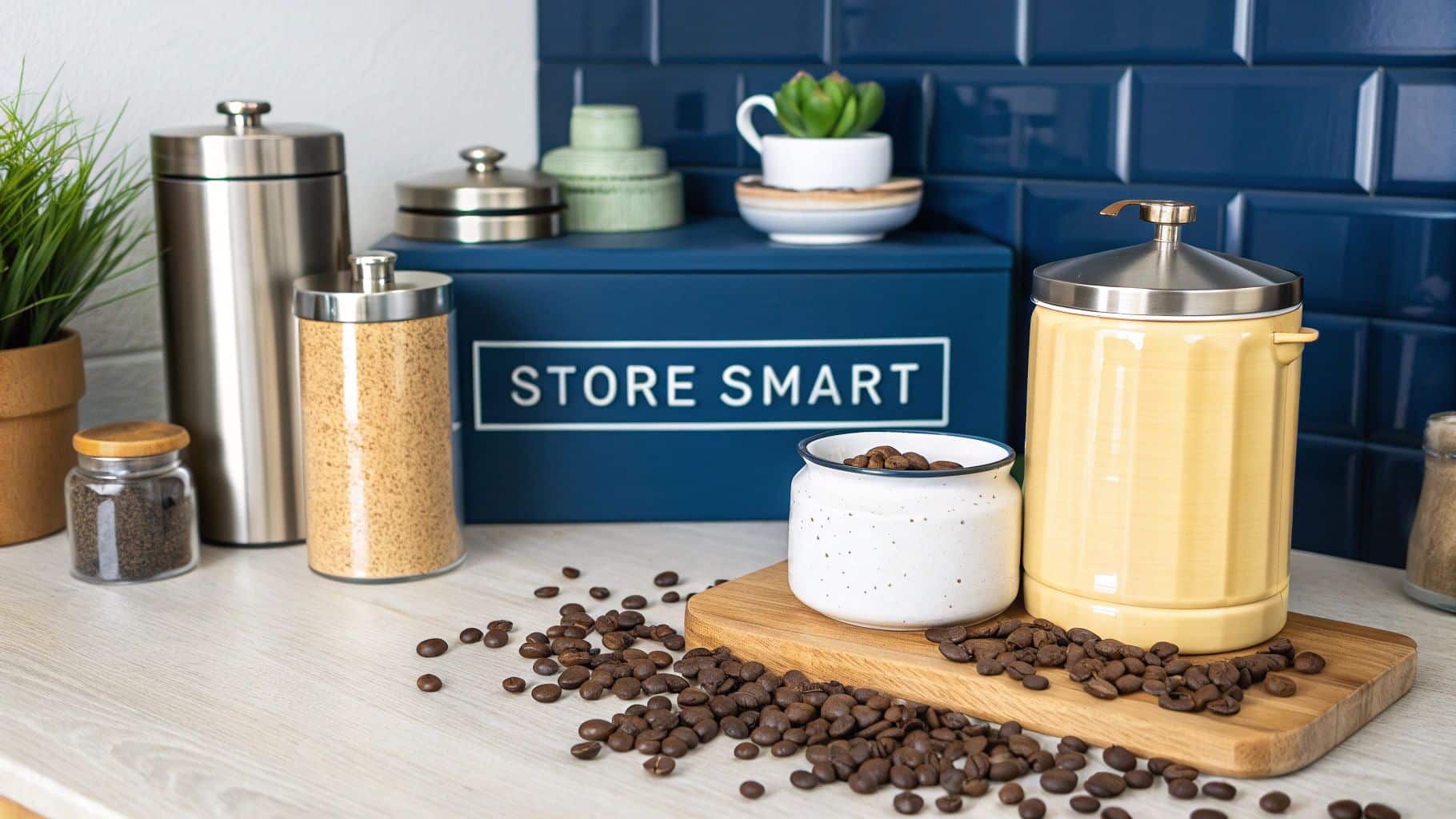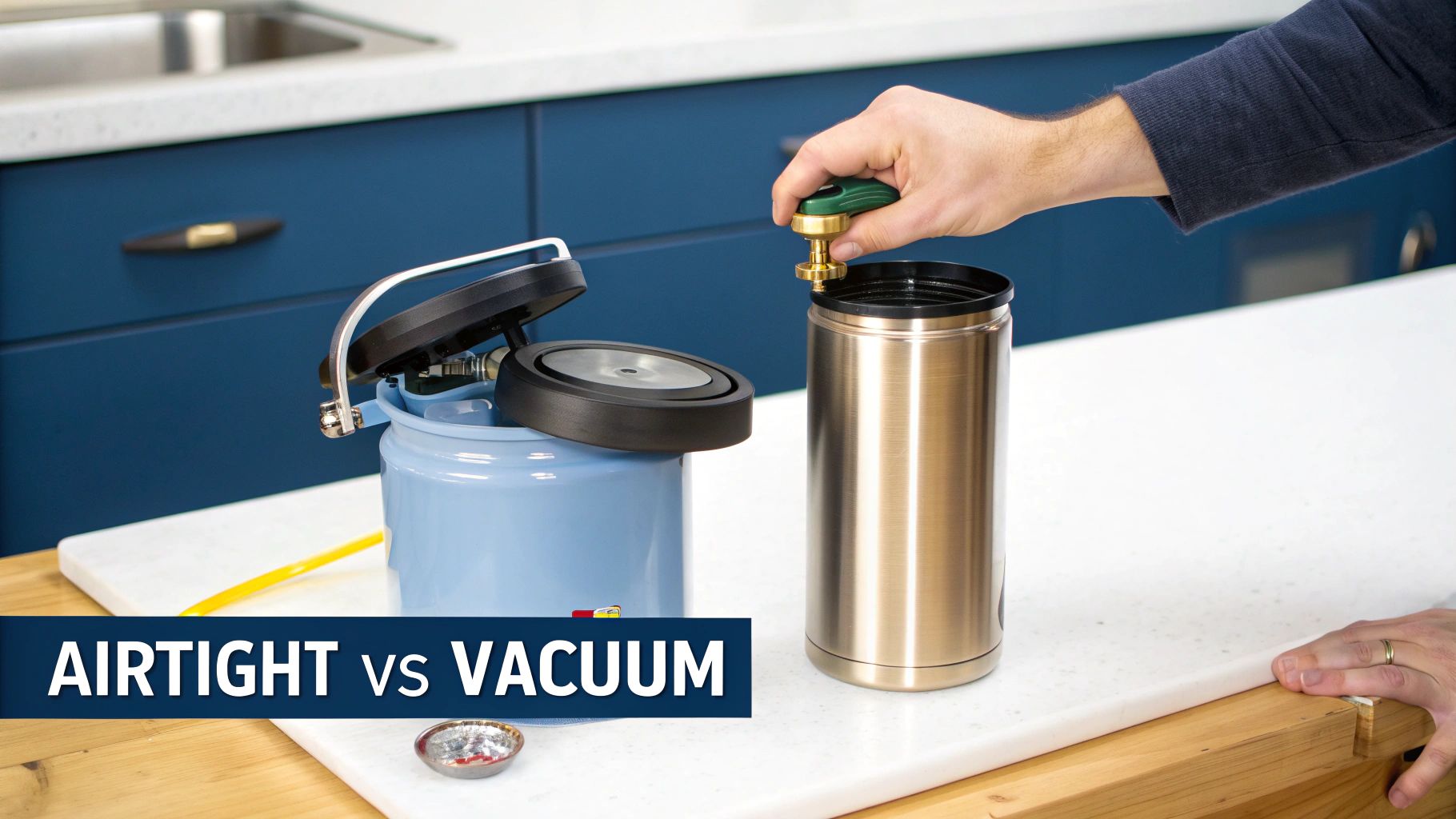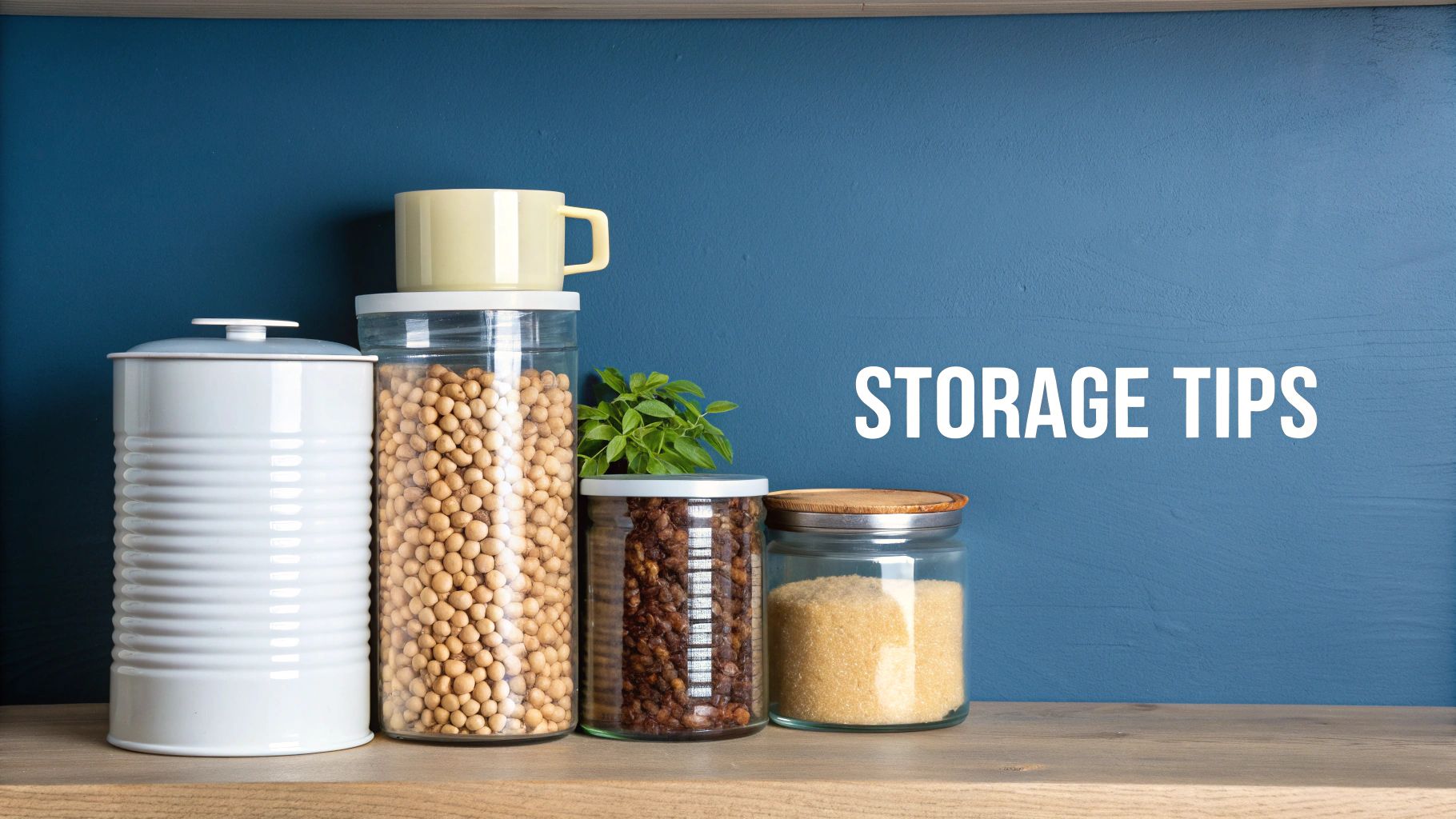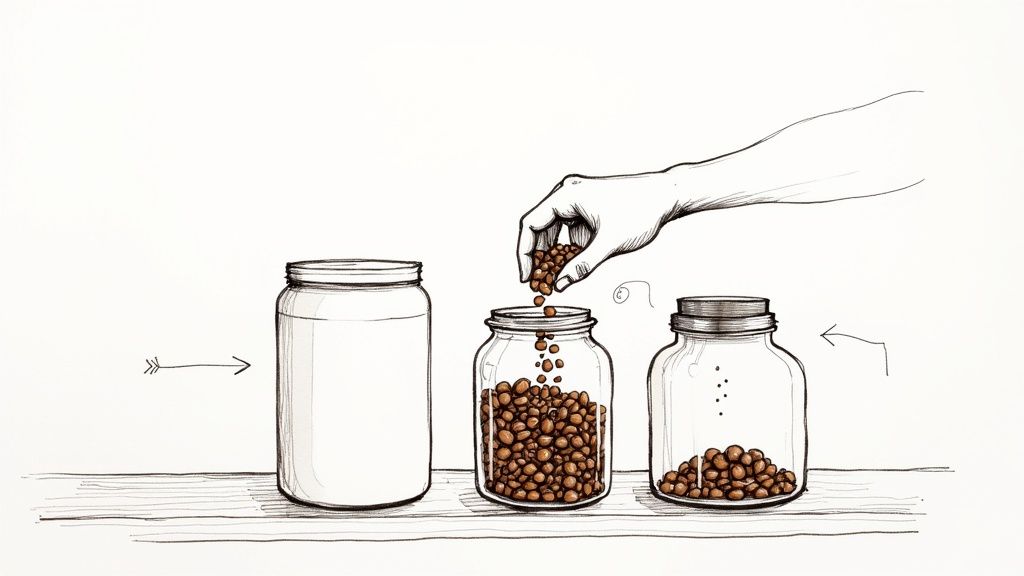UK Guide to Best Coffee Storage Containers

The very best containers for storing coffee are airtight, opaque, and made from inert materials like ceramic or stainless steel. This combination is your best defence against the four enemies of freshness—oxygen, light, heat, and moisture—and it’s the secret to making sure every cup tastes just as good as the day the beans were roasted.
Why Good Coffee Goes Bad (And How to Stop It)
Have you ever wondered why that incredible bag of coffee you brought home last week now tastes disappointingly flat? It’s a common frustration in UK households where a daily brew is a cherished ritual. The culprits are four environmental factors that relentlessly strip your beans of their precious aromatic oils and vibrant flavours.
Getting to know these elements is the first step towards a better coffee experience. Your beans are under constant attack from:
- Oxygen: This is coffee’s number one enemy. Oxidation is a chemical process that starts the moment beans are roasted, causing the volatile compounds responsible for aroma and taste to break down. The result? A stale, lifeless cup.
- Light: Direct sunlight and even strong artificial light contain UV rays. These rays act as a catalyst, speeding up the degradation of the delicate oils and acids that give your coffee its unique character.
- Moisture: Coffee beans are hygroscopic, meaning they absorb moisture from the air like a sponge. This can lead to mould, but more commonly it just dulls the flavour, leaving you with a muted brew.
- Heat: Storing your coffee anywhere warm—near an oven, on top of the fridge, or on a sunny windowsill—is a bad idea. Heat accelerates all the chemical reactions that make coffee go stale.
The Problem with the Roaster’s Bag
Sure, the bag your coffee arrived in often has a one-way valve and a resealable zip, but it’s not designed for long-term storage. Every single time you open it, you’re letting in a fresh wave of oxygen. Worse still, those seals are rarely perfect after you’ve opened and closed them a few times.
Some studies have shown that coffee can lose up to 70% of its flavour within just a couple of weeks if it's repeatedly exposed to oxygen.
A quality container isn’t just another kitchen accessory; it's an essential tool. It preserves the quality and taste the roaster worked so hard to create, ensuring every cup you brew is as delicious as the first.
This is exactly why investing in a proper coffee storage container is so important. It creates a stable, protected environment that shields your precious beans from harm. To dig deeper into the fundamentals, our guide on how to store coffee beans offers even more practical tips. Honestly, it’s the single most effective thing you can do to protect your coffee and guarantee a superior brew every time.
Choosing the Right Material for Your Container
When it comes to the best coffee storage containers, everything starts with one fundamental choice: the material. It’s about more than just how it looks on your kitchen counter; the material you choose has a direct, tangible impact on the flavour and lifespan of your beans. Here in the UK, the most common options each come with their own set of pros and cons when it comes to durability, UV light protection, and taste neutrality.
To keep your coffee tasting its absolute best, you need to shield it from its three biggest enemies: oxygen, light, and heat. This infographic is a great visual reminder of what you're up against.
As the visual shows, these three elements work together to break down the aromatic oils that give your coffee its wonderful flavour. An effective container is your first and best line of defence.
Comparing Your Options
If you ask a professional barista, they'll almost always point you towards opaque containers made from stainless steel or ceramic. There’s a good reason for this. These materials are inert, which means they won't impart any unwanted flavours, and they completely block out damaging light.
- Stainless Steel: An excellent, durable choice that's lightweight and effectively blocks all light. It’s also non-porous, so it won’t absorb old coffee oils that could turn rancid and spoil a fresh batch.
- Ceramic: A fantastic option for its light-blocking properties and classic, timeless aesthetic. Ceramic is completely inert but can be heavier and more fragile than steel.
To make deciding a bit easier, I've put together a quick comparison table that breaks down the strengths and weaknesses of each common material.
Coffee Container Material Comparison
| Material | Oxygen Barrier | UV Protection | Durability | Best For |
|---|---|---|---|---|
| Stainless Steel | Excellent (with an airtight seal) | Complete | High | The all-rounder for serious coffee lovers. |
| Ceramic | Excellent (with an airtight seal) | Complete | Medium | Those who value aesthetics as much as freshness. |
| Glass | Good (with an airtight seal) | Poor (unless tinted) | Medium | Displaying beans, but only if stored in a dark place. |
| Plastic | Varies (can be porous) | Varies (needs to be opaque) | High | A budget-friendly, lightweight option for short-term use. |
This table shows why materials like stainless steel and ceramic consistently come out on top for long-term freshness. They offer the best all-around protection.
Glass containers are a popular sight in many kitchens, but most are a poor choice for coffee. While a product like the Argon Tableware Square Glass Storage Jar 1.1 Litre might look great, it exposes your beans to light, accelerating staleness. Unless the glass is heavily tinted to block UV rays or you plan to store it in a dark cupboard, it’s best avoided for your prize beans.
Choosing the right material is a balancing act between aesthetics, budget, and performance. For the best flavour protection, always prioritise an opaque material over a transparent one.
Finally, there’s plastic. It’s often the most affordable and lightweight choice, but it comes with a catch. Plastic can sometimes absorb odours and oils over time, which can taint future batches of beans. If you do opt for plastic, make sure it’s BPA-free and opaque to offer at least some protection.
To make your decision easier, many excellent coffee storage accessories are available that combine these effective materials with robust sealing mechanisms, giving you the best of both worlds.
Airtight vs Vacuum Sealed: Which Seal Is Best?
Once you’ve settled on the right material for your container, the next big decision is the seal. This one feature is often what separates a decent container from a truly great one, and understanding the difference between airtight and vacuum-sealed lids is the key to keeping your beans vibrant.
An airtight seal is the most common type you’ll come across, usually created by a simple silicone gasket and a clamping lid. Its main job is to stop any new oxygen from getting into the container. Simple, but effective. It traps the air that was already inside when you closed it, which is a massive step up from leaving your beans in the bag or a basic jar.
For most of us who get through a 250g bag within a couple of weeks, a good airtight tin does the job perfectly well. It’ll keep your coffee tasting great from the first cup to the last.
The Power of Removing Oxygen
A vacuum-sealed container, on the other hand, takes things to another level. Instead of just trapping the air inside, it actively removes it. You either push down a plunger-style lid or use a small built-in pump to force the oxygen out, which dramatically slows down the oxidation that makes coffee go stale.
This is a real game-changer if you love buying expensive, single-origin beans and want to savour their complex notes for as long as possible. Research consistently shows that oxygen is the number one enemy of fresh coffee, so getting rid of it makes a tangible difference.
When you're investing in premium coffee, a vacuum canister isn't an extravagance—it's insurance for your beans. It ensures the last cup from the bag tastes nearly as vibrant as the first.
The Special Case for CO2 Valves
You might also spot containers with a small, one-way CO2 valve. These are especially important if you’re working with very freshly roasted beans.
For the first few days after roasting, beans release a surprising amount of carbon dioxide in a process called de-gassing. This little valve is clever—it lets all that CO2 escape without allowing any damaging oxygen to sneak back in.
This feature is absolutely crucial if you’re diving into the world of coffee roasting at home or buying your beans straight from a local roastery. For coffee from the supermarket, which has likely de-gassed long ago, a standard airtight seal is all you really need.
Getting the Container Size Right for Your Coffee Habits
When you're choosing the best way to store your coffee, it's easy to get caught up in materials and fancy seals. But one of the most overlooked details is also one of the most critical: the size of the container itself. It might seem smart to grab a big, impressive canister, but if you're a 250g-bag-a-week kind of person, you could be ruining your coffee without even realising it.
The problem is all that empty space left inside a half-full container. This headspace, as it's known, is filled with oxygen, and oxygen is the mortal enemy of fresh coffee beans. Trapped inside with your precious beans, it immediately starts to degrade them, turning a brilliant brew into something flat and disappointing. A huge, half-empty canister is one of the fastest ways to kill your coffee's flavour.
The real goal is simple: match the size of your container to the amount of coffee you actually buy.
Finding Your Perfect Fit
As a rule of thumb, you want a container that will be 75% to 100% full when you pop in a fresh bag of beans. This keeps that initial blast of oxygen to a minimum and makes sure your coffee stays vibrant for much longer.
- For the daily brewer (250g bags): A smaller canister is your best bet. Something around the 0.7L to 1L mark is perfect for holding a standard bag with very little leftover space.
- For the household supply (500g bags): Look for a medium-sized container, usually in the 1.5L range.
- For bulk buyers (1kg bags): A larger 2L+ canister will do the job nicely, but only if you're actually filling it up each time.
The best container for you is the one that fits your routine. Always aim to leave as little empty space as possible—your coffee will thank you for it.
It's a shame, but the vast majority of coffee in the UK is stored badly. This doesn't just dull the flavour; it also reduces the health benefits. Fresh coffee can oxidise up to twice as fast if it's left exposed. You can find more insights on this in reports about the expanding UK coffee market and its trends on lumina-intelligence.com.
Beyond just volume, think about the practical side of things. Stackable containers are a godsend for saving precious counter space, especially in smaller UK kitchens. And make sure the opening is wide enough to get a scoop in easily. Just as important, it needs to be wide enough for a good clean, otherwise, old coffee oils will build up and spoil your fresh batches.
Essential Tips for Storing and Maintaining Your Coffee
Owning a great coffee storage container is a brilliant first step, but how you use and look after it is what truly makes the difference. A few simple, consistent habits are all it takes to preserve those delicate flavours and ensure every cup is as fresh as the last.
First things first: always buy whole beans if you can. Pre-ground coffee has a much larger surface area exposed to the air, which means it goes stale significantly faster, even when tucked away in a quality container. Grinding right before you brew is probably the single biggest upgrade you can make to your daily coffee routine.
Finding the Right Home for Your Coffee
Location is everything. Your coffee canister should live somewhere cool, dark, and dry. Think of a kitchen cupboard well away from the oven or hob. You definitely don't want to store it on a sunny windowsill or on top of the fridge, as both spots expose your precious beans to damaging heat and light.
And what about that age-old debate: the fridge or the freezer? It’s almost always a bad idea. Every time you take the container out, condensation forms, introducing moisture—coffee’s sworn enemy. Research from the Specialty Coffee Association backs this up, advising an airtight, opaque container stored away from these exact elements. Given that up to 90% of in-home coffee isn't stored optimally, following this simple advice can make a world of difference.
Keeping your container clean is non-negotiable. Over time, coffee beans leave behind oily residues that can turn rancid, imparting a bitter, unpleasant taste to fresh batches.
Regular maintenance is straightforward but absolutely vital.
- Wash Between Batches: Before refilling with fresh beans, give your container a good wash with warm, soapy water.
- Dry Thoroughly: This is crucial. Make absolutely certain it is completely dry before adding new coffee. Even a tiny bit of lingering moisture can spoil the beans.
This simple cleaning routine prevents the build-up of old oils and keeps your coffee tasting pure. Once you're done, you can even find creative ways of composting your used coffee grounds, turning waste into a fantastic resource for your garden.
Your Coffee Storage Questions Answered
Even when you've found the perfect container, a few practical questions always seem to pop up. Let's face it, navigating the world of coffee storage can feel a bit tricky. So, let's tackle some of the most common queries to make sure you're keeping your brew in peak condition.
Should I Freeze My Coffee Beans?
This is one of the biggest debates in coffee, and the short answer is: probably not for your daily stash. Every time you open that container from the freezer, condensation gets in, and moisture is one of coffee's greatest enemies.
However, if you've bought a big bulk bag and want to preserve some for later, freezing can work. The trick is to do it right: portion the beans into a truly airtight, vacuum-sealed bag. They'll be fine for several months, but once you take them out, that's it—never, ever refreeze them.
How Long Will Coffee Actually Stay Fresh?
This is the million-dollar question. In a quality airtight canister, you can expect whole beans to hold onto most of their flavour for around 3-4 weeks from the roast date. A proper vacuum-sealed container might even stretch that to 5-6 weeks.
Just remember that pre-ground coffee is a completely different story. It loses its magic much, much faster. Even in the best storage, you'll want to use it up within one to two weeks. It's the perfect illustration of why grinding just before you brew makes such a huge impact on your final cup. For more on that, our guide on how to brew coffee walks you through the whole process.
The real value of a great container is consistency. It slows down the staling process, ensuring the last cup you brew from a bag is nearly as vibrant and flavourful as the first.
Do I Really Need a CO2 Release Valve?
You'll see these little one-way valves on lots of coffee bags and some containers. They are most useful for coffee that's very freshly roasted—we're talking within the first few days. As the beans "de-gas," the valve lets that CO2 escape without letting damaging oxygen in.
If you’re buying your beans from a supermarket, they have almost certainly finished de-gassing by the time you get them home. In that case, a simple, robust airtight seal becomes far more important than a valve.
Ready to elevate your daily brew? Explore the exceptional range of freshly roasted beans from Seven Sisters Coffee Co and discover the difference that quality and care make in every single cup. Find your new favourite today at https://sevensisterscoffee.co.uk.





